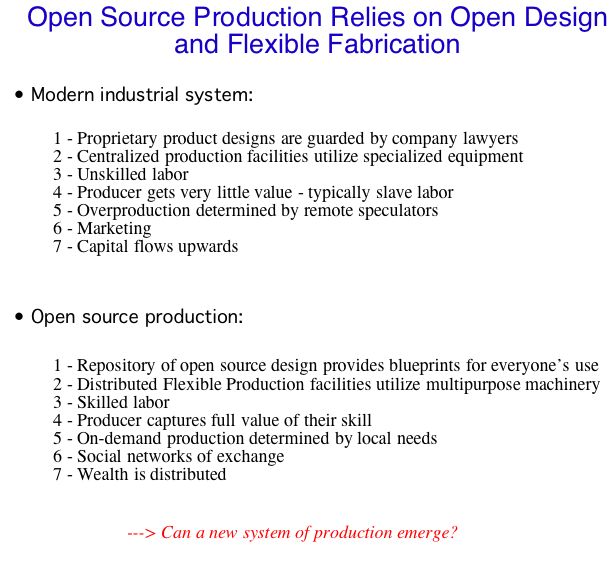Slide 7
This page was tagged as a candidate for deletion. If this page does not meet our criteria for deletion, please remove this notice.
(Explanation: contents moved to Slide 1)
Slide 1 - Slide 2 - Slide 3 - Slide 4 - Slide 5 - Slide 6 - Slide 7 - Slide 8 - Slide 9 - Slide 10 - Slide 11 - Slide 12 - Slide 13 - Slide 14 - Slide 15 - Slide 16 - Slide 17 - Slide 18 - Slide 19 - Slide 20 - Slide 21 - Slide 22 - Slide 23 - Slide 24 - Slide 25 - Slide 26 - Slide 27 - Slide 28 - Slide 29 - Slide 30 - Slide 31 - Slide 32 - Slide 33
What is the open source production model? It is where a repository of collaboratively-developed, openly accessible design blueprints serve as the foundation for all types of production. This could be factories or industry, or farms and architecture firms. Open design applies to a wide range of activity that results in physical products – or it could be design for a school curriculum or an improved legal and financial system. The key is transparency and access.
Let’s look at open source production and compare it to a typical factory or corporation. The open source variant relies on a repository of open design – not proprietary design protected by company lawyers. It is based on multipurpose production machinery in small flexible production facilities – not specialized equipment in large factories. It is based on skilled labor, not slave wage. The open source producer captures the value of their skill, produces for local needs, utilizes social networks or word of mouth for marketing. Overall, wealth is distributed to the producer, and to the buyers – and the producer is an asset who brings wealth to others in the form of quality products.
